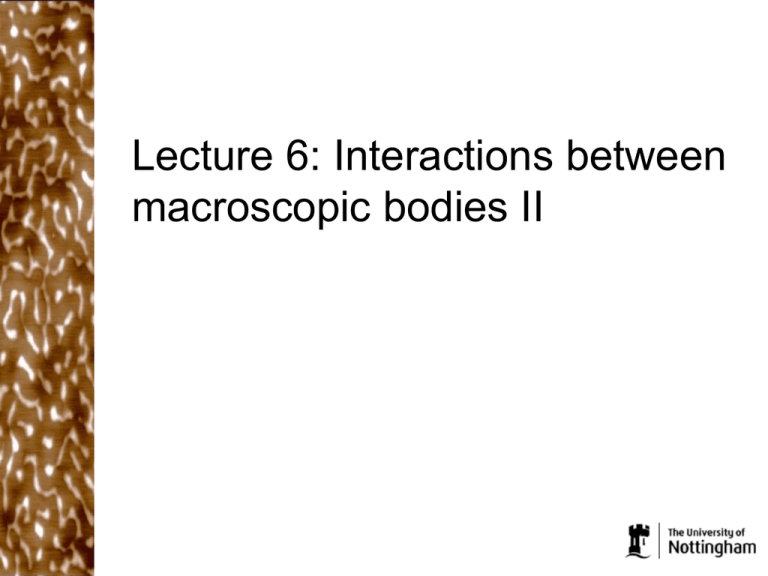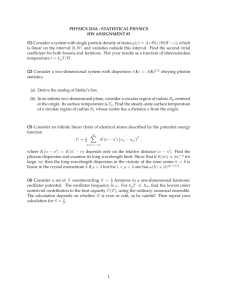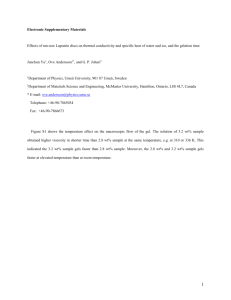JSS6
advertisement

Lecture 6: Interactions between macroscopic bodies II What did we cover in the last lecture? 1) Dispersion interactions between atoms/molecules and macroscopic bodies 2) Dispersion interactions between two macroscopic bodies In this lecture… 1) Interactions between macroscopic bodies continued 2) The effects of geometry on dispersion interactions 3) Determining the energy scale of dispersion interactions (Hamaker constant) 4) Range of interactions between macroscopic bodies 5) Magnitude of forces between macroscopic bodies Interactions between a sphere and a solid Problem 2: Derive an expression for the dispersion forces which act between a sphere of radius R (for separations D>>R) and a semi-infinite solid if the number density of atoms in the slab and sphere are n1 and n2 respectively. Summary of results Dispersion Interaction energy between an atom/molecule and a semiinfinite solid Dispersion Interaction energy between a flat slab of area, S, and a semiinfinite solid Dispersion Interaction energy between a sphere of radius, R, and a semiinfinite solid U ( D) nC 6D 3 n1n2CS U ( D) 2 12 D n1n2 CR U ( D) 3D All of these are longer range than dispersion interaction between isolated molecules 2 The Hamaker Constant The strength of the dispersion interaction between materials is often quantified in terms of the Hamaker constant, A A12 n1n2 C 2 Measured in Joules n1 and n2 are the number densities of atoms/molecules in the two interacting materials (m-3) C is the ‘strength’ of the interaction between an atom/molecule from one material and an atom/molecule from the other (Jm6) A12 is the Hamaker constant for materials 1 and 2 Dispersion interactions and Hamaker constants We can rewrite our expressions for the dispersion interaction energy between two macroscopic bodies in terms of the Hamaker constant Dispersion Interaction energy between a flat slab of area, S, and a semi-infinite solid n1n2CS A12 S U ( D) 2 2 12 D 12D Dispersion Interaction energy between a sphere of radius, R, and a semi-infinite solid n1n2 2CR A12 R U ( D) 3D 3D Dispersion Forces and Hamaker constants We can also write the forces in terms of the Hamaker constant Dispersion force between a flat slab of area, S, and a semiinfinite solid Dispersion force between a sphere of radius, R, and a semi-infinite solid dU A12 S F ( D) dD 6D 3 dU A12 R F ( D) dD 3D 2 So for a given geometry we can determine the strength of the dispersion interaction A12between two materials by measuring forces Some other important geometries The geometry of the macroscopic bodies is important in determining the separation dependence of the dispersion interaction U ( D) Parallel cylinders U ( D) A12 R1 R2 3D R1 R2 A12 L R1R2 3 R R2 12 2 D 2 1 Sphere-sphere 1 2 A12 U ( D) R1 R2 6D L Perpendicular cylinders How big are Hamaker constant values? P190 Surface and Intermolecular forces by J. Israelachvili Values of A typically lie in the range 10-21 to 10-19 Joules Note: kTroom = 4.41x 10-21J What is the range of dispersion forces between macroscopic bodies? We can calculate the range of the interaction by comparing dispersion and thermal energies i.e. |U(Drange)| ~ kT For a sphere of radius R and a solid surface we have A12 R U ( D) kT 3Drange Hence A12 R Drange 3kT For values of T=300K, R=10 nm and A12=10-19J Drange ~ 10R = 100 nm Note: Drange(atoms) ~ 0.3 nm How big are the dispersion forces between macroscopic bodies? We can also calculate the magnitude of the forces exerted on macroscopic bodies due dispersion forces Sticking with the sphere and surface we have that dU A12 R F ( D) 2 dD 3D If R=10 nm, A12=10-19J When D=10nm, When D=1nm, F= 3 x 10-12 N ~ 3 pN F= 3 x10 -10 N ~ 0.3 nN But can we measure forces this small? Force between two surfaces In the last lecture we showed that the force between a perfectly flat slab and a semi-infinite solid surface is A12 S F ( D) 3 6D If the area of the slab is S=10-4m2 and A12 = 10-19J. What is the force between the slab and the surface at a separation of 0.3 nm? Ans: ~20,000 Newtons This is a very large force! So why don’t all surfaces stick together irreversibly? Summary of key concepts 1) Dispersion interactions between macroscopic bodies occur over significantly longer ranges than for isolated atoms/molecules 2) We can derive expressions for the dispersion interaction energy and forces between macroscopic objects 3) The strength of the dispersion interaction can be quantified in terms of the Hamaker constant A 4) Dispersion forces on nanoscale objects can be on the pN to nN scales






